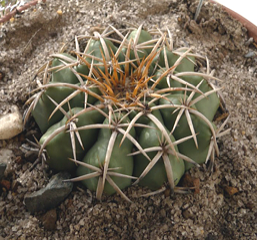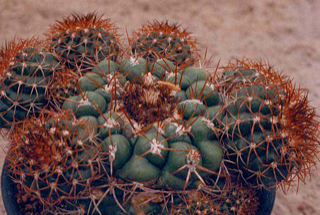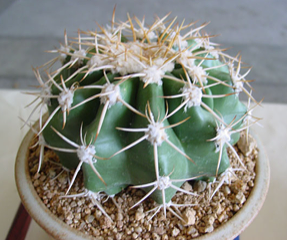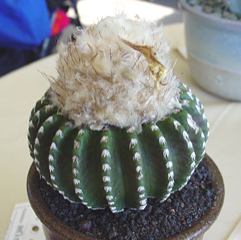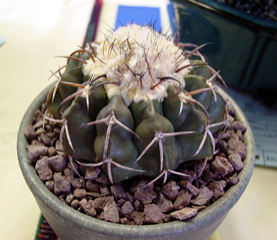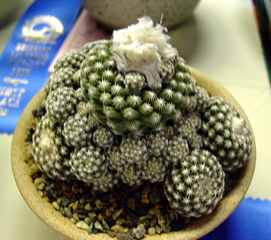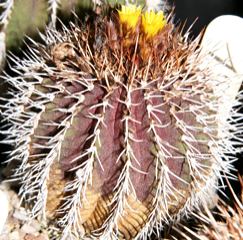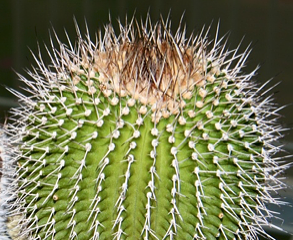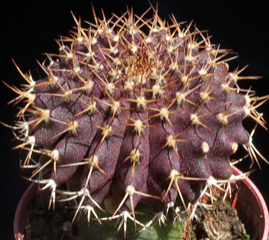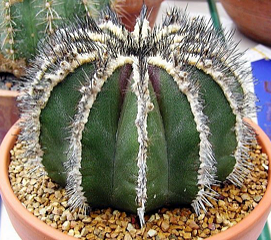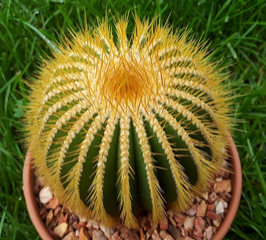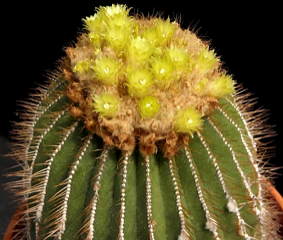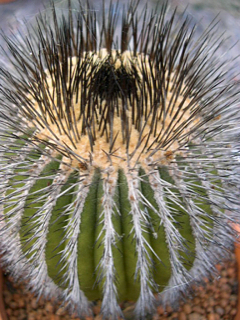Submitted by: Jim Tanner
Discocactus contains a dozen species of tropical cacti. Most species grow in rock outcrops in the tropical forests, and are endangered in their natural habitat.
Mature Discocactus stop growing, and instead divert their energy into growing a cephalium. The cephalium is a specialized flowering head, generally covered with fibers. Discocactus blooms in summer, on and off. The flowers are generally white and open in late afternoon until the following morning. Many species have fragrant flowers.
Discocactus are tropical species, and should be kept warm in winter. Many species are extremely difficult to keep on their own roots and are generally grafted. The grafted plants are less cold sensitive, but none has any frost tolerance.
Three species from Brazil make up the genus Uebelmannia, these plants feature globose, to cylindrical stems that have distinct ribs lined with spines. The epidermis of the plants has a granular texture to it and can be a bright green, waxy-gray, or even dark purple in color. The spines typically stand in contrast in bright white, golden, or black coloring with areoles forming a continuous line along the ribs. These characters, while hard to describe, give the plants a most striking and unique appearance. The flowers, however, would not be considered anything special among the cactus family as they are small little yellow funnels which come out near the stem tip.
In cultivation, this genus is considered one of the more difficult to grow. This makes them rather hard to find either for sale or trade. As a result, many new to the hobby are unfamiliar with the genus and are greatly impressed when they first encounter it.
LATIN LOOKUP – Loquerisne Latine (Do you speak Latin)?
The meanings of latin plant names on this page – from http://davesgarden.com/guides/botanary/
- bahiensis [ba-hee-EN-sis]
Of or from Bahia (Salvador), Brazil. - buiningii [byoon-ING-ee-eye]
Named for Albert Frederik Henrik Buining, 20th century prominent Dutch expert of Brazilian cacti. - Discocactus [disk-oh-KAK-tus]
From the Greek diskos (disc), referring to the typically circular and flattened shape. - flavispina [flav-ih-SPIN-uh]
Yellow spines. - gummifera [gum-MIF-er-uh]
Gum-bearing. - horrida [HOR-id-uh, hor-ID-uh]
Prickly, bristly. - horstii [HORST-ee-eye]
Named for Leopoldo Horst, 21st century Brazilian plant collector. - pectinifera [pek-tin-EE-fer-uh]
Comb-bearing. - placentiformis [pla-sent-ih-FOR-miss]
From the Latin (flat cake), referring tot he flat and circular shape. - rubra [ROO-bruh]
Red colored. - Uebelmannia [yoo-bel-MAHN-ee-uh]
Named for Werner Uebelman, Swiss grower and collector of cacti in cacti in Brazil, Uruguay and Paraguay.
